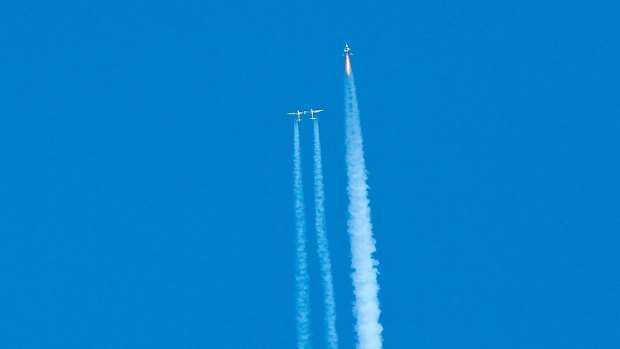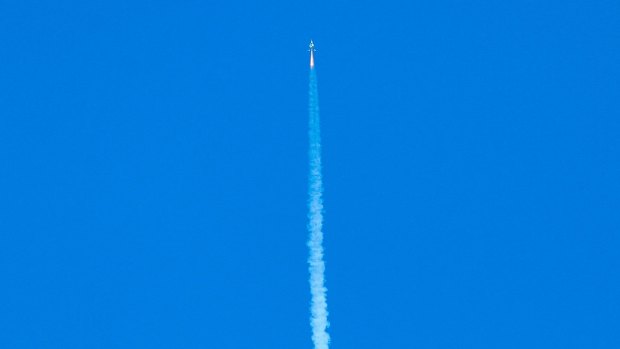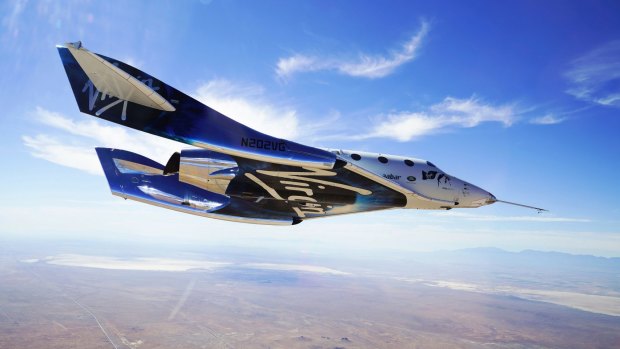This was published 5 years ago
Richard Branson's Virgin Galactic spacecraft reaches space for the first time
By Christian Davenport

The Virgin Galactic craft launches for the edge of space. Credit: AP
Virgin Galactic launched a spacecraft more than 50 miles (80 km) high Thursday morning, meeting the Federal Aviation Administration's definition of space and capturing a long-elusive goal for the company founded by Richard Branson that one day wants to fly tourists high through the atmosphere.
Though it did not reach orbit, the flight was the first launch of a spacecraft from United States soil with humans on board to reach the edge of space since the Space Shuttle was retired in 2011. And it gave Virgin Galactic an edge in the race for human spaceflight, as a number of companies, including SpaceX, Blue Origin and Boeing, work to develop spacecraft capable of flying humans.
With two seasoned pilots in the cockpit - Mark "Forger" Stucky and C.J. Sturckow - the vehicle known as SpaceShipTwo was ferried to an altitude of about 43,000 feet (13,000 metres) by a mothership. Like a bomb, the spacecraft was released into a freefall before the pilot ignited the engine, propelling the spaceplane faster than the speed of sound.

VSS Unity reached an altitude of 271,268 feet.Credit: AP
Soon, the vehicle pointed almost straight up, as it streaked through the same skies over the California desert where Chuck Yeager first broke the sound barrier in 1947. The spacecraft reached a height of 51.4 miles (82.7 km), hitting a top speed of Mach 2.9, before descending and landing at the company's space port in Mojave.
On the ground, a gaggle of press, space enthusiasts, including Branson and his guests watched the flight, tilting their heads skyward.
For Branson, the launch was the culmination of years' worth of lofty dreams and tragic setbacks as he sought to build what he calls "the world's first commercial spaceline." He founded Virgin Galactic after buying the rights in 2004 to the technology behind SpaceShipOne, the spacecraft funded by Microsoft co-founder Paul Allen that made it to the edge of space three times that year, winning the $US10 million Ansari X prize and becoming the first privately funded vehicle to fly humans to space.

The VSS Unity craft during a supersonic flight test in May.Credit: AP
Thursday's launch was also a major milestone for a growing commercial space industry, which for all its triumphs has yet to show it can routinely fly humans into space. But that may soon change.
Blue Origin, the space company founded by Jeff Bezos, also plans to fly tourists, though to a higher altitude and with a rocket that launches vertically, not a spaceplane. (Bezos owns The Washington Post.)
Its first test flights with humans on board are scheduled for next year.
SpaceX, the company founded by Elon Musk, and Boeing are under contract with NASA to fly astronauts to the International Space Station, the orbiting laboratory, by as early as next year.
As the plight of Virgin Galactic shows, ending government's long-held monopoly on human spaceflight has been difficult. Despite the long odds, Branson started his quest to open space to the masses with his typical bravado, vowing the company would soon be taking tourists by the hundreds on awe-inspiring jaunts to the cosmos.
But years passed, the program suffered delay after delay and in 2014, a fatal setback: The spacecraft came apart mid-flight, killing Michael Alsbury, the pilot.
As federal investigators investigated the crash, Branson pondered whether to continue, ultimately vowing to press on.
In 2016, he unveiled a new spaceplane, dubbed Unity, and the company started its test program again, slowly pushing the envelope on test flight after test flight. Thursday's flight was a key milestone that the company says will push it closer to flying tourists from Spaceport America, Virgin Galactic's futuristic launch facility in New Mexico. So far, more than 600 people have signed up, paying as much as $US250,000.
The company's ultimate goal is to build a series of spaceports around the globe, "and we're operating multiple times a week at each one of those and enabling tens of thousands of people to experience space," George Whitesides, Virgin Galactic's chief executive, said in a recent interview.
Eventually, the company would like to turn those spaceports into "future hubs for a network of intercontinental transportation nodes" where the spaceships can transport people across the globe in a matter of hours.
In the long term, he said, the company wants to fly "into major airports because we have a winged vehicle that can integrate smoothly in traffic patterns," Whitesides said.
That goal is still "many years out," he said. "But that's the evolution-so that at the end of it you've built up, step-by-step, a capability to go between continents in an hour or two."
The Washington Post
Sign up for the Traveller newsletter
The latest travel news, tips and inspiration delivered to your inbox. Sign up now.